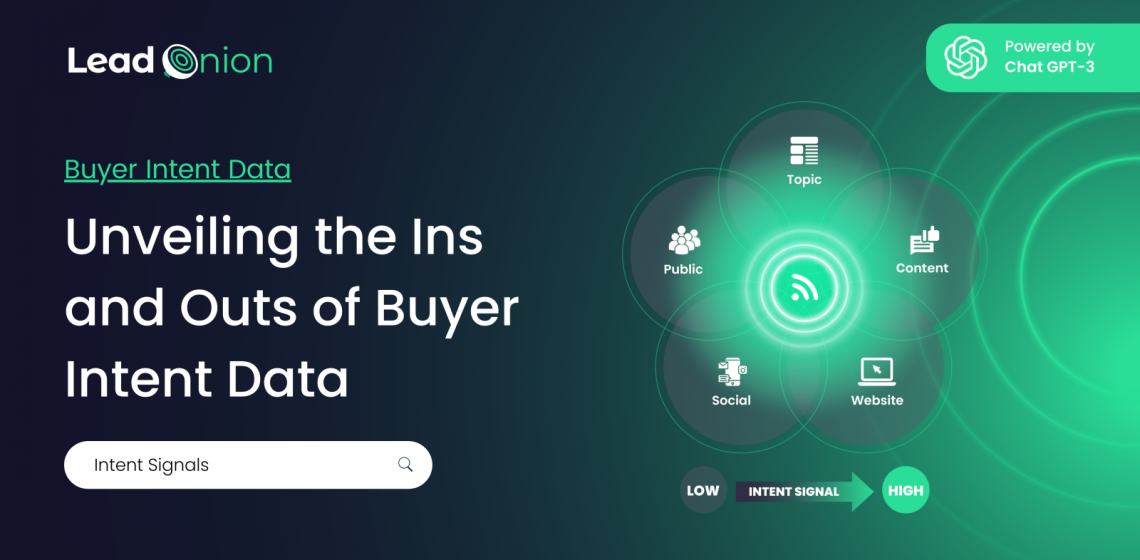Understanding your customers' needs and desires is crucial for staying ahead of the competition. With the explosion of online data, there's a goldmine of information waiting to be tapped into. One such treasure trove is buyer intent data – the key to unlocking invaluable insights into consumer behavior. If you're ready to take your sales strategy to the next level, you've come to the right place. In this blog, we'll delve deep into the world of buyer intent data, exploring what it is, why it matters, and how you can harness its power to drive meaningful results for your business.
In B2B marketing and sales, the cornerstone of a successful campaign lies in the quality of your data and its strategic utilization. Savvy marketers and sales professionals understand the pivotal role data plays in nurturing and expanding their pipelines. Amidst the plethora of data available, one type stands out for its effectiveness: Buyer Intent Data.
Surprisingly, only 1/4 of B2B companies currently harness this powerful resource, despite a staggering three-quarters citing increased deal closures as their primary sales objective. It's high time to acquaint yourself with this game-changing tool that holds the potential to elevate your business strategies to new heights.
Buyer intent unveils invaluable insights into the purchasing intentions of potential customers. This rich data serves as a roadmap, illuminating the behavior of your ideal prospects and offering a comprehensive view of their engagement with your product or service online.
These cues, often referred to as “signals,” stem from diverse prospect activities, spanning interactions with competitors, website visits, or exploration of your offerings. Remarkably, these signals emerge well before prospects make direct contact, visit your website, or fill out a form. Once a prospect's actions trigger a signal, a buyer intent engine captures it, consolidating these behaviors into a roadmap for pinpointing where prospects stand in their buying journey.
The crux of buyer intent lies in forging direct connections with prospects within your target market who align with your customer personas and are actively seeking what you offer. Imagine the efficiency gained in the nurturing process when every prospect in your pipeline is poised for purchase! With a striking 49% of companies prioritizing customer acquisition, buyer intent emerges as an indispensable, all-knowing tool to engage with organizations already in search of the solution you provide.
But How Does It Work?
In today's era of online commerce, millions of individuals worldwide are actively engaging online in their quest for products that meet their needs. Whether interacting with website content or delving into specific search engine topics, the digital footprint left behind by potential customers is immense. According to research by Google, a staggering 89% of B2B researchers utilize the internet during their purchasing journey, underscoring the significance of this data.
Leveraging advanced technologies like machine learning and AI, these vast databases of information can be analyzed to extract crucial insights, forecast buyer intent patterns, and monitor consumer engagement. The crux of buyer intent's success lies in its sophisticated algorithms, meticulously designed to monitor interactions, analyze prospect behavior, and pinpoint individuals who fit your buyer profile.
As a result, the buyer intent algorithm identifies prospects displaying high purchase intent and seamlessly integrates them into your database, streamlining your lead generation process.
Where Does Intent Data Come From?
The collection of buyer intent data hinges on its various sources, which are categorized into three main types: first-party, second-party, and third-party data. Traditionally, buyer intent was predominantly sourced from first-party data alone. However, with the evolution of technology and the rise of mobile shopping, buyer intent data can now be gleaned from all three categories.

1. First-Party Data:
First-party data is the information directly under your control and readily accessible to you. This includes data such as website visits, customer interactions on social media or via email, insights from social listening tools, and offline engagements like attendance at industry events or trade shows.
2. Second-Party Data:
Second-party data refers to first-party data collected, analyzed, and subsequently sold by another company. Examples of this include data from review sites like G2 and ContentGine. While G2's data is valuable, operationalizing it can be challenging as it primarily offers company-level insights, necessitating supplementation with contact-level details for key decision-makers. On the other hand, ContentGine's data is focused at the contact level, giving you the exact person showing the intent.
3. Third-Party Data:
Third-party data is gathered from activities occurring outside your owned digital platforms. This encompasses mentions of keywords and topics, user reviews, and references to competitors on external sources such as blogs, B2B publishers, forums, and online communities focused on business or technology.
Additionally, public data from social media networks, such as LinkedIn, contributes to this category of data.
5 Benefits of Buyer Intent Data
1. Efficient Prospecting
Effective lead generation is crucial for business growth. As your enterprise expands, it's essential that your operational frameworks can adapt to attract a broader audience without significant resource investment. A buyer intent-centric approach boosts sales team confidence and streamlines the identification of SQLs, shortening the sales cycle. Insights from buyer intent data refine marketing efforts to cater precisely to prospective clients' interests. Integration of third-party B2B intent data offers unparalleled access to prospects' research behaviors. By harnessing intent data, your content can be tailored to resonate with each prospect, ensuring relevance and personalization during the consideration phase.
2. Bolster Sales Results
Only 18% of marketers find their outbound efforts deliver high-quality leads for sales teams. Utilizing B2B buyer intent provides invaluable insights to strategically place your content where it will have the most impact, thereby maximizing the potential of your outbound sales. Buyer intent data is a crucial aspect of prospecting, offering a high return on investment by guiding you to qualified leads progressing through their buying journey. According to Think With Google, B2B buyers conduct an average of 12 searches before visiting a brand's website, with 90% of these searches focused on their business purchases. Leveraging buyer intent enables you to pinpoint B2B decision makers who are actively researching solutions, enhancing your targeting efforts.
3. Close the Gap in Sales and Marketing
When 27% of salespeople spend over an hour daily on administrative tasks and data logging, rather than selling, while only 34% of their time is dedicated to actual selling, it's evident that a gap exists between marketing and sales. This loss of valuable time underscores the need to enhance the efficiency of your sales funnel and dispel the notion of sales solely responsible for lead generation. Intent data empowers you to accurately predict buyer purchasing intent. Rather than relying on traditional lead scoring methods based solely on in-platform actions, intent data allows for a more nuanced approach. By scoring leads based on actions occurring beyond your platforms, your sales team can focus on prioritizing interested leads and engaging with those ready to make a purchase, thereby optimizing their time and efforts.
4. Improve Account Based Marketing Campaigns
In B2B, targeting has shifted to account-based marketing, on an individual-level, and at the top of the agenda is building relationships with the right prospects. By utilizing intent data, you have access to specific information, otherwise unavailable, about each individual prospect, including industry, job title and contact details.
For your content to remain relevant, buyer intent proves an effective resource in understanding the interests and behaviours of your B2B target market.
Using it in this way, you are able to view the scope of the buyer journey and each prospects’ stage within it. From there, you are able to personalize messages that appeal to those in decision-making roles in your target companies.
5. Create Relevant, Impactful Content
Effective research into your target market's interests is crucial for ensuring that the content you create resonates with your audience. Intent data enables you to understand the topics your prospects engage with and the platforms they use. For instance, knowing the questions or topics your prospects are exploring allows you to tailor your content to address their needs precisely.
By responding to these questions at the moment prospects express them, you can strengthen your content narrative and drive an increase in qualified leads to your site.
Why Lead Onion?
Lead Onion represents a cutting-edge solution for sales and marketers, consolidating 18 diverse sources of intent signals from 10 intent-driven tools into one comprehensive platform. Like peeling back layers, Lead Onion empowers us to unravel the complexities of the buyer's journey with precision and finesse, guiding us towards strategic mastery.
By embracing Lead Onion, the path to unparalleled success in B2B demand generation becomes clear. Let's come together to peel back the layers and embark on a journey towards refined, customer-centric success.
Download the guide to learn more.


(2).png)
